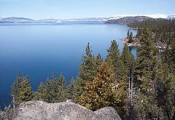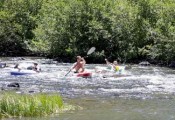 Three consecutive mild, dry winters have resulted in lower than normal water levels in Lake Tahoe and the Truckee River. As of July 22nd, the lake level was a 6,223.98 feet above sea level. The natural rim is 6,223 feet. The water level in the Truckee River was 3.58 feet on July 21st. In order to release additional water from Lake Tahoe, the water level downstream at Floriston must be below 500 cubic feet per second. A long-standing federal rule defines that level as the Floriston Rate, and the U. S. District Court Water Master is prohibited from releasing extra water from Lake Tahoe as long as the flow at Floriston exceeds that amount.
Three consecutive mild, dry winters have resulted in lower than normal water levels in Lake Tahoe and the Truckee River. As of July 22nd, the lake level was a 6,223.98 feet above sea level. The natural rim is 6,223 feet. The water level in the Truckee River was 3.58 feet on July 21st. In order to release additional water from Lake Tahoe, the water level downstream at Floriston must be below 500 cubic feet per second. A long-standing federal rule defines that level as the Floriston Rate, and the U. S. District Court Water Master is prohibited from releasing extra water from Lake Tahoe as long as the flow at Floriston exceeds that amount.
 Local rafting companies in Tahoe City have suspended operations and missed the opportunity to take advantage of the “best month” in normal water years—August. Aaron Rudnick of Truckee River Rafting has indicated that “losing August is going to hurt the most.” IRIE Rafting Company, known for white water rafting on the Truckee River, is only scheduling trips until August 1st. Frank Wohlfahrt, president of IRIE, indicates that “it is financially painful for us to lose a third of our season.”
Local rafting companies in Tahoe City have suspended operations and missed the opportunity to take advantage of the “best month” in normal water years—August. Aaron Rudnick of Truckee River Rafting has indicated that “losing August is going to hurt the most.” IRIE Rafting Company, known for white water rafting on the Truckee River, is only scheduling trips until August 1st. Frank Wohlfahrt, president of IRIE, indicates that “it is financially painful for us to lose a third of our season.”
The Sand Harbor boat ramp will be closed starting July 28th and boaters will be directed to use the boat ramp at Cave Rock. Larry Boerner, owner of the commercial vessel Tahoe Gal, indicates that there are rocks and other obstacles beginning to show now that require much more careful navigating on the east shore of Lake Tahoe. The Tahoe Gal can operate when the water level is one foot below its natural rim, but it would be difficult. Jim Phelan of Tahoe City Marina reports more propeller damage because of the shallower shores, and some sailboats are unable to come into the marina at all.
According to the U. S. Drought Monitor, 100 percent of California was in “severe drought.” It will take one or even two wet winters to recover from the drought. Fingers crossed—everyone is hoping El Nino will bring a wet, snowy winter.
To read the entire article, click on the Sierra Sun link.



Leave a Reply